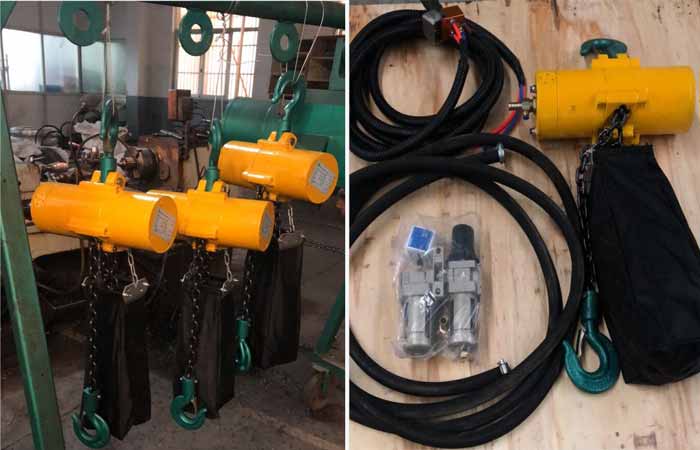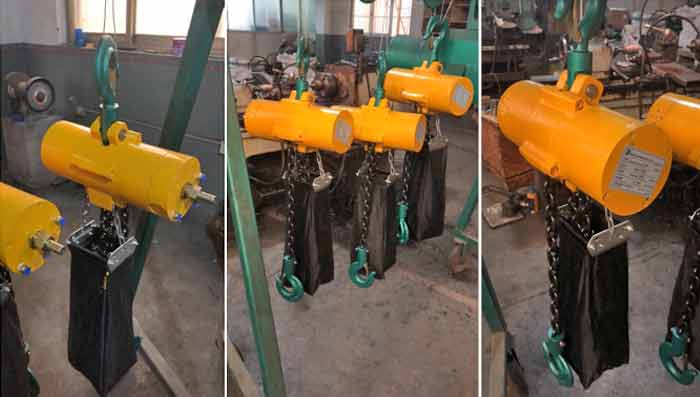Air hoist is a type of material handling equipment and hoisting equipment which are widely used to lifting or lowering the load material generally using chain or wire rope with a lifting hook on its end . The power source of air hoist is , as its name implied, the compressed air supplied from air compressor, and also it is called as “pneumatic hoist”.

Main components & parts
Air hoist is mainly composed of hand control valve (handle type and hand rope type), main control valve, air motor,hanging ,reducer, brake mechanism, interlocking mechanism and other parts.

Features of main air hoist parts & components
- Manual control valve: mainly composed of handle, valve body and buttons. Operate the button to open the valve to control the communication between the air passage of the main control valve and the air passage of the motor. Or pull rope operation to pull the rotation of the pendulum rod to achieve the opening of the valve, which can realize step-less speed change.
- Main control valve: It is mainly composed of left and right valve stems, connecting rods and valve plate. By switching the left and right air passages, the air distribution work of the air motor is completed.
- Air motor: mainly composed of rotor, stator, front and rear end covers and blades. When the air distributor of the main control valve sends compressed air into the motor, the blades rotate at a high speed with the rotor.
- Hanging: Mainly composed of upper hook, hanging body, sprocket, chain, lower hook and other parts. Rely on the positive and negative rotation of the sprocket to complete the ascending and descending motion.
- Reducer: It is mainly composed of a shell and a set of planetary reduction mechanism. When the high-speed shaft of the air motor is input to the deceleration mechanism, the torque is increased by deceleration, and the torque is output from the final stage to the lifting sprocket.
- Brake mechanism: mainly composed of brake cone, brake ring and cylinder. Distribute the air to the cylinder through the main control valve to separate the brake cone and the brake ring to release the brake.
- Chain mechanism: mainly composed of rotating shaft, swing frame and reset spring. When ascending and descending to the position, it plays a role of anti-collision and protection.

Pneumatic hoist is currently the most ideal lifting equipment in the world. It has long been widely adopted in industrialized developed countries. It is a new generation of lifting tools for enterprise safety in production, improving efficiency and reducing costs. The working principle of pneumatic hoist is to convert the pressure energy of compressed air into mechanical energy to achieve the purpose of lifting goods. It has the incomparable advantages of electric hoist:
- No electric spark is generated, which completely solves the explosion-proof problem of lifting equipment. Applicable to: hazardous locations in Zone I, including IIC, Group T5 and below.
- When raising or lowering, the running speed is fast. It is 2 to 3 times of the electric hoist, and can be steplessly variable speed.
- Resistant to acid, alkali, steam, and high dust.
- Small in size, light in weight, and 1/3 to 1/8 of the weight of an electric hoist.
- The positioning is more accurate, and the goods can be accurately positioned to centimeters, achieving zero impact.
- Clean and environmentally friendly, safe and reliable, the internal lubrication system eliminates air pollution, and can be used in special or harsh environments such as humidity and high dust.
- Handling is labor-saving, small in size and low in quality. The solid structure design makes the operation reliable and the maintenance is small.
- The air cut-off protection prevents the goods from falling suddenly due to the sudden interruption of the air source, which improves the safety and reliability during the operation.
- Pneumatic hoists can be widely used in petroleum, chemical, coal, textile, machinery production, ships, munitions and other fields.
- Safe operation specification
- The rigorous promotion is greater than the load of the product’s lifting capacity.
- It is strictly forbidden to stand under the lifting object when lifting heavy objects.
- Strictly use the load chain as a lifting chain.
- If the lifting chain is twisted, kinked or damaged, it is forbidden to use the pneumatic hoist.
- It is not allowed to hang the lifting object with load for too long.
- It is not allowed to use the load chain as a welding ground, and it is not allowed to weld on the pneumatic hoist or hoist chain.
- It is not allowed to use the upper and lower stop devices to brake the pneumatic hoist.
- Side pulling or dragging is not allowed.
- It is forbidden to insert bolts between the lifting chains or connect them by other methods.
- Check the wear or damage of the pneumatic hoist and the brake or limit device before each shift.
- Periodically check the pneumatic hoist thoroughly and replace worn or damaged parts.
- Lubricate and maintain the equipment as required.
- Ensure that the air source is closed during the maintenance period of the air hoist.
- Personnel using pneumatic hoist should be trained in safety and use.
- The pneumatic hoist uses compressed air as the power to drive the pneumatic motor to rotate, and the torque is increased by speed change (deceleration) to complete the lifting work.

If you have any questions about air hoists, please feel free to contact us.



